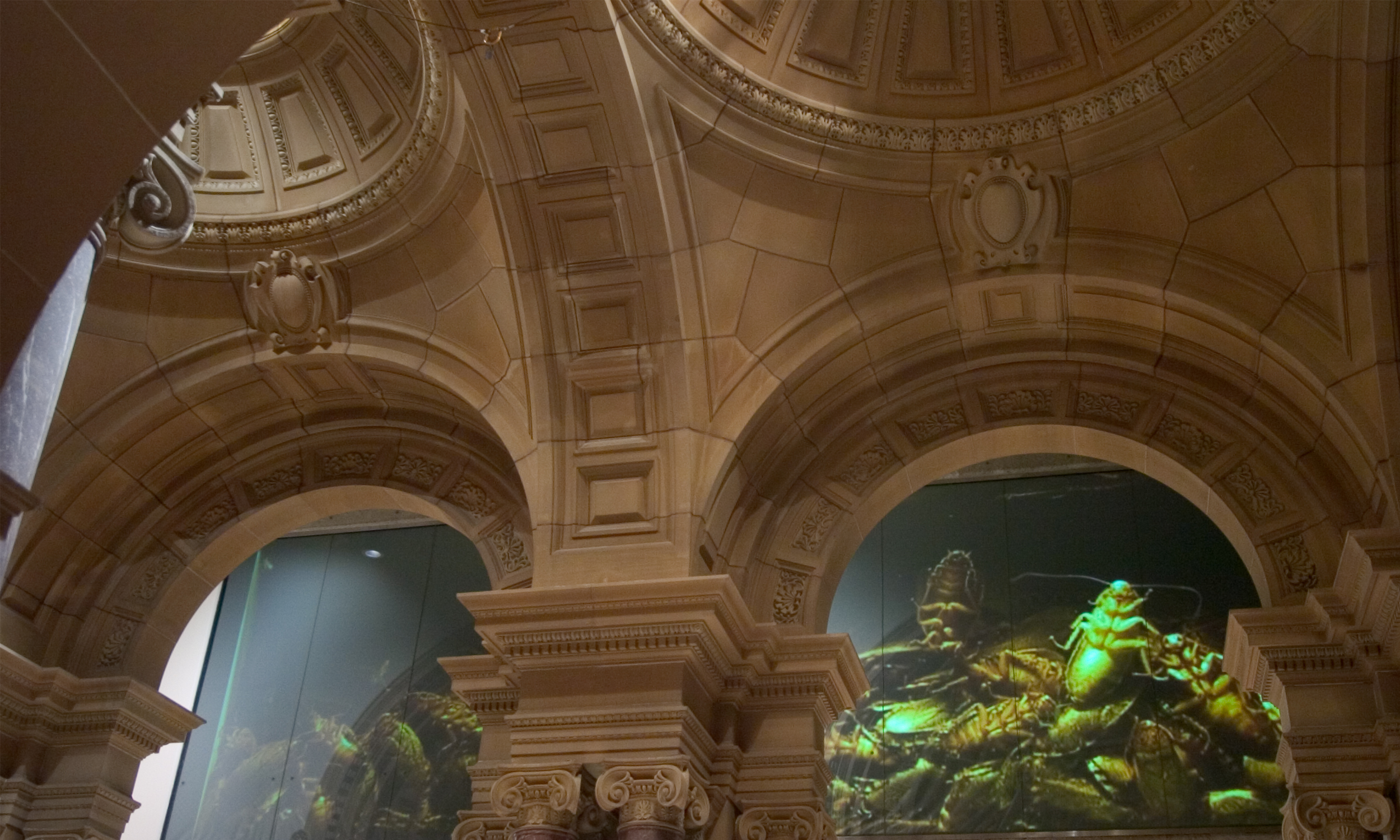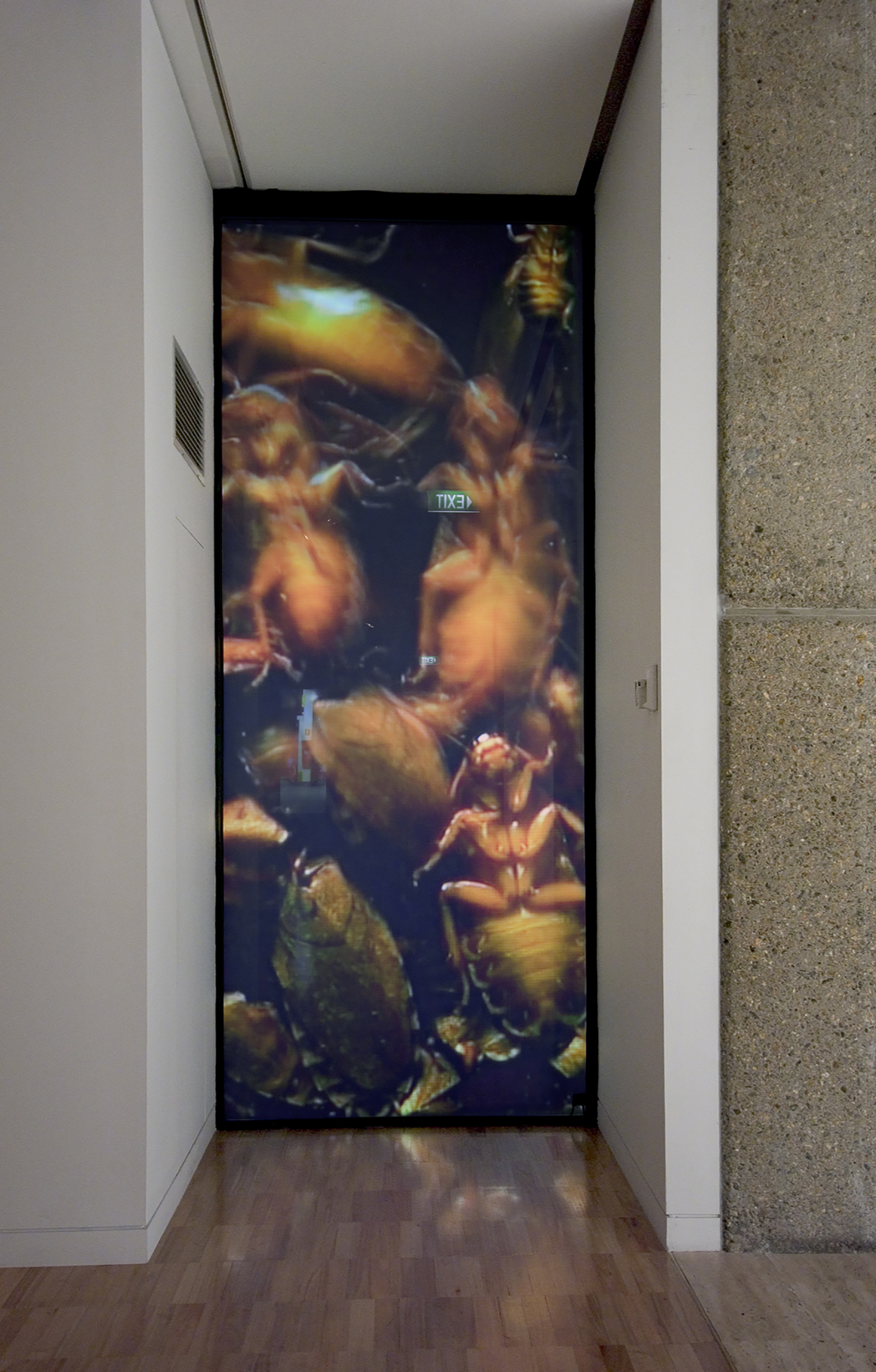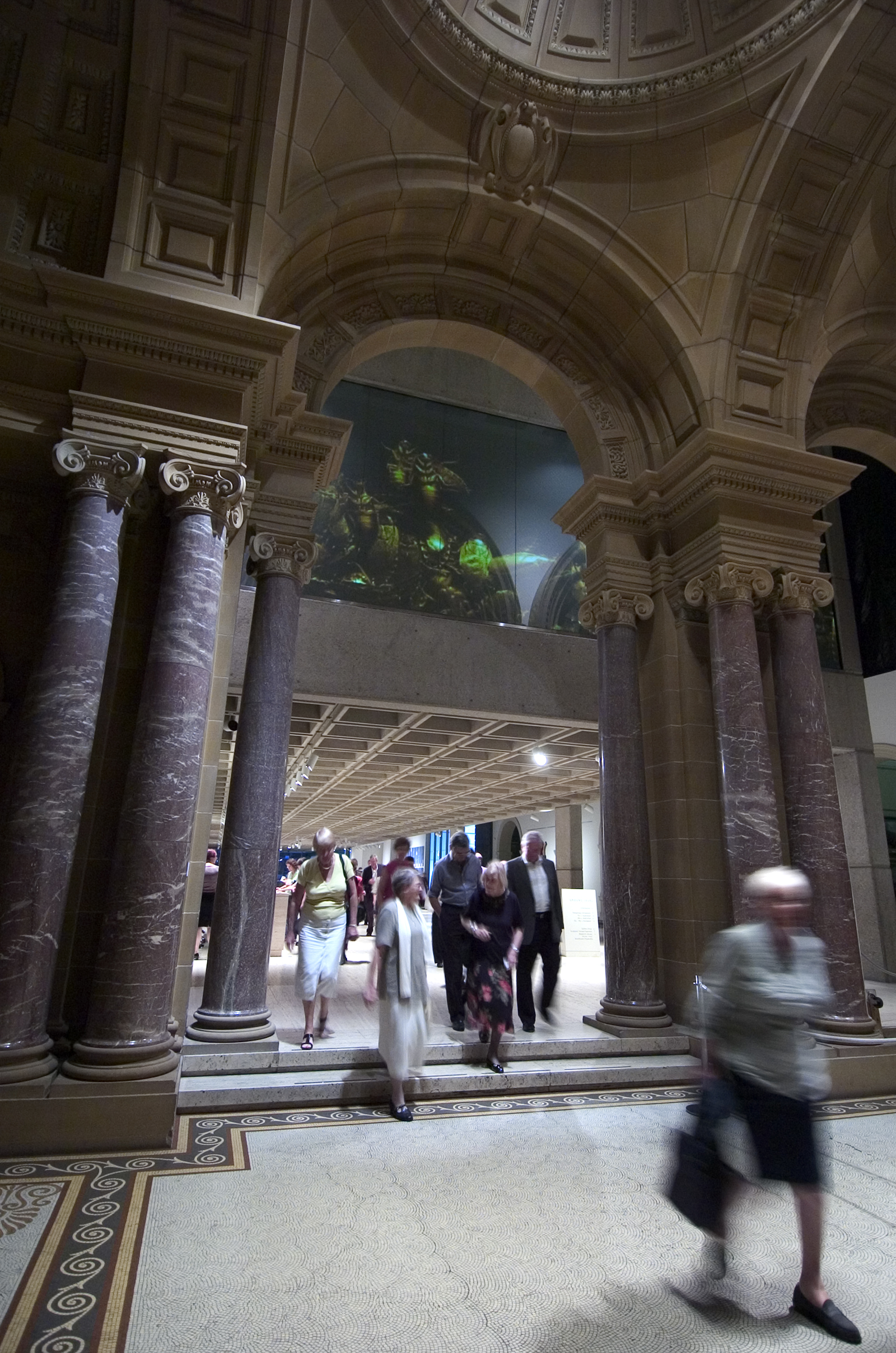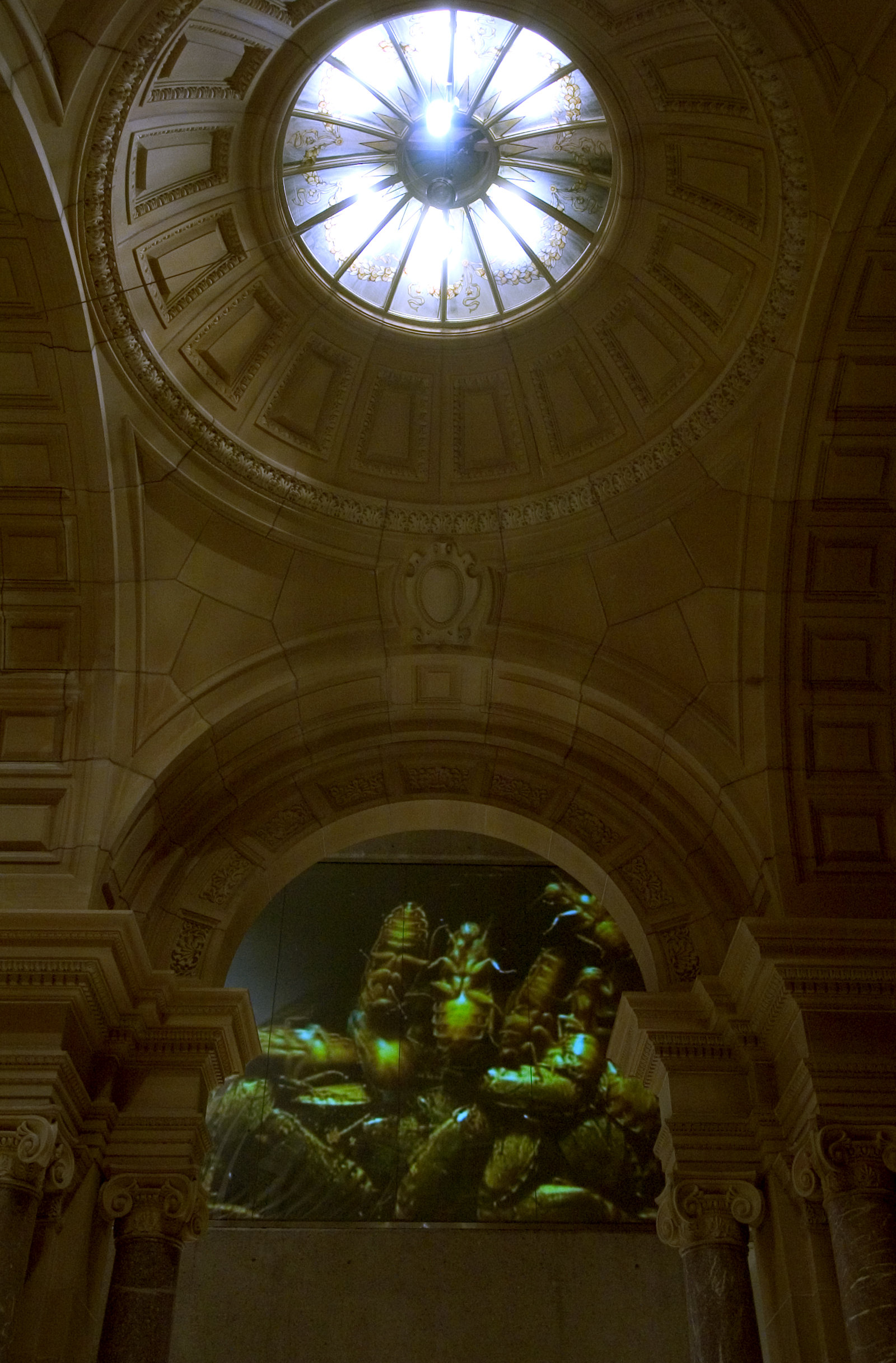Project Description
Project Description
2004 Anne Landa Exhibition Art Gallery of New South Wales Sydney, Australia
2006 Wave Front Exhibition Tokyo Wondersite, Japan
Essay by Wayne Tunnicliffe
Curator of Contemporary Australian Art
The late 19th-century neoclassical grandeur of the Art Gallery of New South Wales foyer is designed as a transition zone between the world at large and the temple to the arts within. It is a liminal space in which the artifice of extravagant architectural decoration sets out to evoke and inspire reverence and contemplation. Human skill and creativity are emphasised and yet once the visitor becomes accustomed to the dizzying layers of ornamentation, the scale of the foyer is not quite as awe-inspiring as it first appears and its colonial ambition seems to exceed the reality of its size and structure. Despite the natural materials of sandstone and marble, it firmly draws a line between the cultivated nature of the Domain parklands outside and the hermetic climate controlled environment within that excludes natural cycles of life, death and decay.
Entering the foyer during the Landa exhibition, an uneasy rustling, scrabbling sound draws the eye upwards to the shocking sight of hundreds, if not thousands, of looming oversized cockroaches. Climbing over each other in frenzied movement, struggling to escape, they press up against the glass wall of the upper level exhibition gallery framed in the foyer arches. The ubiquitous household cockroach can be disturbing enough life-sized, let alone gigantic and en masse. Its remarkable adaptation skills have allowed it to co-habit with humans in even the most seemingly sterile domiciles. Our anxious relationship with the cockroach is not just because it is an insect that many people find visually repellent, but also because is virtually impossible to eradicate; its survival success reminds us that we do not control nature quite as effectively as we might think we do. It is the return of a repressed other to our urbane civilisation which casts us back into primeval animal competition in which our ascendancy is not quite guaranteed. While giant cockroaches may remain an urban myth, it is true that they can withstand much higher exposure to nuclear radiation than humans and are probably more capable of adapting to environmental change.
The cinemascope scale of these cockies recalls the popular Cold War sci-fi horror film genre of suddenly oversized creatures and bugs, a subgenre of the monster-beast movie spawned by such classics as King Kong (1933) and Godzilla (1954). A sudden reversal of size in our natural environment, potentially caused by our own scientific advances upsetting the laws of nature, seems to be an underlying nightmarish fear of our collective subconscious. This was evident in 1950s nuclear irradiation insect fantasies including Tarantula (1955), Theme (1954, giant ants) and Beginning of the end (1957, giant grasshoppers). More recently oversize nature has made a reappearance in the farcical Anaconda (1997) and the more engaging Jurassic Park (1993). Contested space is mutant, alien and threatening, a nightmarish vision of the familiar and detested become enormous and potentially vengeful, about to right all those wrongs inflicted on its brother and sister cockroaches stamped underfoot, sprayed, flushed down the sink, but never quite eradicated. Size is compounded by quantity, and numerical superiority is already something that cockroaches have fully in hand.
Nature situated somewhere between the pre-modern and the post-modern has featured in Walsh’s work before. A ‘green man”, recalling the pre-Christian imagery of nature gods, appeared in Humanature, an outdoor projection work which has had several incarnations since 1994. This wood spirit is a gigantic human head projected onto a tree at night, creating an eerie morphosis of tree and human. Walsh has made this work for outdoor events and music festivals, and one version was an interactive live-feed where the tree, like some ancient oracle, would answer questions put to it. In a work closer to Contested space, Walsh rear-projected an image of giant fish onto a shop floor, leaping around until being slowly submerged in water. The arresting spectacle of the shop filling with liquid and giant creatures was compounded by the anxious feeling that at any moment the glass would shatter and the streets fill with water and huge fish.
Walsh’s work is almost always site-specific, addressing the architecture but also the social, cultural and environmental context of a particular location. He often utilises cinematic spectacle as a way of intervening into already visually competitive urban and architectural environments. The archaic imperial values that the neoclassical order of the foyer suggests contrasts with the concrete and glass functionalism of the architecture that immediately follows. The modernist minimalism of the exhibition space is designed to exclude the natural, the organic and the decorative, both in its design of right angles, rectangular masses and clean lines, and through the careful use of climate control, UV filtering, and seals against the outside environment. In turning the antinature of this architecture into a home to the struggling brown carapaces and spindly legs of the order Blattodea, Walsh’s projection inevitably recalls Kafka’s parable of modernist alienation, Metamorphosis.
The opening sentence of Kafka’s short story contrasts matter of fact modernist literary form and fantastic content: ‘When Gregor Samsa woke one morning from uneasy dreams he found himself transformed in his bed into a monstrous insect.’1 Kafka’s unpalatable fusion of the human and the insect embodies the anxious relationship between individual identity and productivity within bureaucratic systems that define both work and social life. Walsh’s Contested space reflects this anxiety through utilising the spectacle of a morphologically exaggerated nature located within the particular architectural and ideological confines of a state art institution. The institutional parameters and the exhibition space itself seem to require Walsh’s uneasy vision, suggestive of Deleuze and Guattari’s comment in their analysis of Kafka, ‘It seems that the most modern functionalism more or less voluntarily reactivated the most archaic or mythical forms. There, too, there is a mutual penetration of two bureaucracies, that of the past and that of the future…’2
1. Franz Kafka, Metamorphosis (1915), Hesperus Press, London 2002, p3
2. Deleuze & Guattari, Kafka: towards a minor literature, University of Minneso Press, Minneapolis 1986, pp 75-76, cited in Anthony Vidler, Warped space: art, architecture, and anxiety in modern culture, MIT Press, Cambridge Mass 2000.
Artist statement by Craig Walsh
CONTESTED SPACE continues a series of installations, which question the cultural, social, ethical and functional objectives of the built environment. These works explore the tensions between the urban and natural environments through a juxtaposition of habitats and the subversion of architectural function. Transforming specific sites within the built environment (constructed to isolate the human species from the natural environment) into a dwelling occupied by non-human species, invites the viewer to contemplate the influence these environmental tensions have on the human condition and our relationship to the natural world. Formally, The audiences perception of reality is further questioned through the interaction of the projected subject matter with the architectural spaces the projections occupy.
Specifically, Contested space presents what are, arguably, the most despised and persecuted co-inhabitants of our built environment confined within the inner sanctum of high culture (the Gallery). This magnified occupancy of a colony of cockroaches, experienced within a gallery context will undoubtedly draw many interpretations from an insect, which has a long history of association and comparison with the human species. It is the expressed aim to confront the audience with certain urban realities not only through the specific subject matter but the spatial and social conditions the cockroaches are experiencing. The title references not only the congestion and resistance of the cockroaches within this restricted space but defines the ongoing conflict between humans and roaches for living space.
The determination of the human species to dominate the planet and have complete control over our interaction with the natural world has lead to the construction of a built environment, which seeks a defined separation from the natural environment. The cockroach stands as the ultimate antagonist in achieving these goals, as they not only ignore efforts to exclude but ultimately share all that we have.he proposed installation would be a variation on a new work being developed for the Anne Landa awards at The Art Gallery of NSW in December. The projection work in Sydney will occupy an existing 10 x 3 meter glass wall facing the vestigial architecture at the northern end of the gallery as well as the entrance doorway to the allocated gallery space. The large glass wall will have two rear projections synchronized to fill that entire surface. The doorway will have a glass surface with rear projection screen covering the door cavity. The overall appearance will be of a gallery three quarters full with 1500 oversized cockroaches visible through the large glass surface from the entrance to the main gallery and the doorway internal to the gallery. The projections will be accompanied by a sound track of the roach’s moving/scratching the glass.




